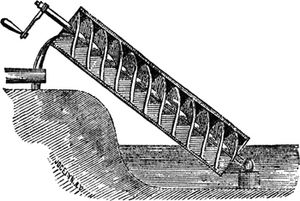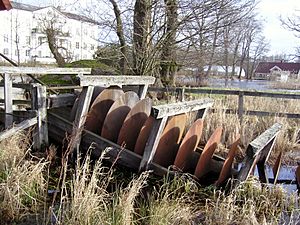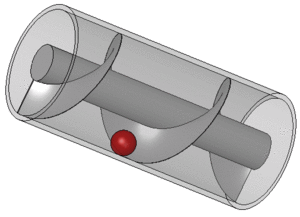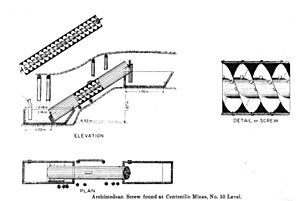Archimedes' screw facts for kids
The Archimedes' screw is a clever machine. It helps lift water or other materials from a low place to a higher one. It's named after Archimedes, a very famous Greek thinker and inventor. He lived a long time ago, from about 287 to 212 BC. However, some people believe this device was used in Egypt even before Archimedes' time.

Contents
- History of the Archimedes' Screw
- How Does an Archimedes' Screw Work?
- Parts of an Archimedes' Screw
- How Archimedes' Screws Are Made
- Uses of the Archimedes' Screw
- Advantages of the Archimedes' Screw
- Examples of Archimedes' Screws in Action
- Archimedes Screw Turbine
- Cool Facts About the Archimedes' Screw
- Images for kids
- See also
History of the Archimedes' Screw
The Archimedes' screw has a very old and interesting past.
Some experts think it was first used in ancient Egypt and Mesopotamia. People used it there to water their farms. Archimedes is known for describing the screw pump around 234 BC. This was when he visited Egypt. He studied the device and explained how it worked. That's why it's named after him today. The screw helped lift water from rivers and lakes. This water was used to irrigate fields. It also helped drain water from mines and even from inside ships.
How Does an Archimedes' Screw Work?
Imagine a long tube with a spiral-shaped blade inside. This blade looks like a giant screw. The tube is placed at an angle. Its bottom end dips into the water.
When you turn the screw, it scoops up water at the bottom. Then, it moves the water up along the spiral path inside the tube. The water keeps moving until it pours out at the top. It's a bit like walking up a spiral staircase. Instead of lifting water straight up, the screw moves it along a gentle, winding path. This makes it much easier to raise water to a higher level.
Parts of an Archimedes' Screw
An Archimedes' screw usually has a few main parts:
- Outer Cylinder or Trough: This is the outside part that holds the screw. It can be a closed pipe or an open channel.
- Helical Screw or Blade: This is the spiral-shaped part inside the cylinder. It's the part that actually lifts the water. Think of it as a winding staircase for the water.
- Shaft: This is the central rod. The screw is attached to it. When you turn the shaft, the screw spins around.
- Handle or Motor: This is what makes the screw turn. It could be a handle you turn by hand. It could also be a windmill or an electric motor.
How Archimedes' Screws Are Made
An Archimedes' screw is made by wrapping a sloped surface around a cylinder. The screw itself is a spiral surface. It goes around a central cylindrical shaft inside a hollow pipe. The screw is turned using different power sources. These can include a windmill, people working by hand, animals, or an electric motor. As the shaft turns, its bottom end scoops up water.
Uses of the Archimedes' Screw
The Archimedes' screw has been used for many things. It was important in the past and is still useful today:
- Watering Crops: Long ago, it helped farmers water their crops. It lifted water from rivers and canals to higher ground.
- Draining Water: It was used to remove water from mines. It also drained low-lying areas. For example, in the Netherlands, they used it to create polders. These are lands reclaimed from the sea.
- Cleaning Water: Today, these screws are used in sewage treatment plants. They help move wastewater and solid materials.
- Making Electricity: Sometimes, water flows into the top of the screw. This makes the screw spin and generate electricity. It's a clean way to make power.
- Moving Materials: Similar screws, called screw conveyors, move other things. They move grains, powders, and other materials in factories and on farms. You can even find them in snow blowers and machines that harvest crops!
- Helping Fish: They can safely lift fish from one place to another. This is useful in fish farms.
- Supporting Buildings: Believe it or not, an Archimedes' screw was even used to help stabilize the Leaning Tower of Pisa!
Modern Uses Today
Today, the Archimedes' screw is still used in some ways. It can be very big or small. Large screws pump away rainwater during storms. They also lift water or wastewater. They are also used to move dry bulk materials, like grains.
Advantages of the Archimedes' Screw
The Archimedes' screw has many good points:
- It's a simple machine. It has few moving parts. This makes it easy to build and take care of.
- It can pump water that has mud, sand, or other bits in it. It won't get blocked easily.
- It's very good at lifting water, especially for short heights.
- When used to make power, it's safe for fish and other water animals.
Examples of Archimedes' Screws in Action
You might see Archimedes' screws in unexpected places:
- Some water parks use them. They lift water to the top of slides and other rides.
- Chocolate fountains use a screw. It pumps melted chocolate to the top. Then, the chocolate flows down the tiers.
- Edinburgh Airport uses Archimedes' screws. They collect extra water from the airfield and nearby areas.
Archimedes Screw Turbine
The Archimedes' screw can also work as a turbine. An Archimedes screw turbine (AST) can be a power plant. It can provide electricity in country areas or far-off places. The good things about the AST are that it is friendly to water animals. It also works very well and steadily.
Cool Facts About the Archimedes' Screw
- The Archimedes' screw is also called the water screw. Other names are the Egyptian screw or hydrodynamic screw.
- Archimedes never said he invented it. But people gave him credit for it 200 years later.
- It's one of the first known hydraulic machines. These are machines that use liquids to do work.
- The first steamship to use a screw propeller was named the SS Archimedes. This was to honor Archimedes and his invention.
- Some researchers think this device helped water the Hanging Gardens of Babylon. This was one of the Seven Wonders of the Ancient World.
Images for kids
-
An Archimedes' screw seen on a combine harvester
See also
 In Spanish: Tornillo de Arquímedes para niños
In Spanish: Tornillo de Arquímedes para niños






